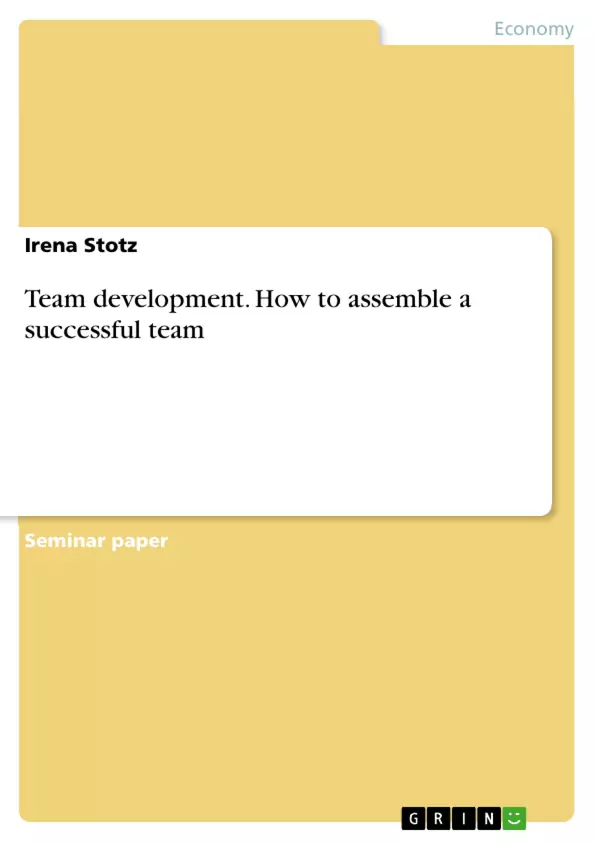Teamwork is the most important factor in achieving success in competition for companies. Teamwork should support companies to operate effectively and flexibly in the market.
For employee’s teamwork is also important; in every job advertisement teamwork is required. And the higher an employee rises on the career ladder, the more important teamwork becomes.
Previously, employees often work in departments, these days in many companies the employees work in project or task orientated teams. The task of today’s managers is to build a cohesive and successful team out of a group of individuals. This team has to work together for a specific time and afterwards they will have to work developing new projects.
This assignment highlights successful teams and how they can be assembled and work together. This will be demonstrated in the second chapter using Belbin’s team role inventory. To begin with, the different team roles will be described and afterwards the differences between unsuccessful and winning teams will be discussed.
After a successful team is assembled, they are paced through the stages of team development. The most famous model of team development is the five stages by Bruce W. Tuckman, which will be analyzed in the third chapter. Later, the phases of team development will be shown. The limits of this model will also be illustrated.
The fourth chapter summarizes the development of this work.
Inhaltsverzeichnis (Table of Contents)
- 1 Introduction
- 2 Belbin's Team Role Inventory
- 2.1 Team Roles
- 2.2 Unsuccessful and Winning Teams
- 3 Phases of Team Development
- 3.1 The Stages of Team Development
- 3.2 Limitations of the Model
- 4 Conclusion
Zielsetzung und Themenschwerpunkte (Objectives and Key Themes)
This assignment aims to provide insights into the dynamics of successful teams and how to effectively assemble them. It explores the key concepts of Belbin's Team Role Inventory and the stages of team development, analyzing how these elements contribute to team effectiveness.- Team Roles and Their Impact on Team Success
- The Importance of Team Role Diversity for Effective Collaboration
- The Stages of Team Development and Their Associated Challenges
- Factors that Contribute to Unsuccessful Teams and Strategies for Improvement
- The Use of Belbin's Model for Practical Team Development Applications
Zusammenfassung der Kapitel (Chapter Summaries)
Chapter 1: Introduction
This chapter sets the stage for the assignment by highlighting the critical role of teamwork in achieving organizational success in a competitive market. It emphasizes the growing importance of teamwork in the workplace, particularly in the context of project-based work environments. The chapter also introduces the overall focus of the assignment: exploring the factors that contribute to the formation of successful teams.Chapter 2: Belbin's Team Role Inventory
This chapter delves into the work of Meredith Belbin, examining his renowned Team Role Inventory and its implications for team performance. It begins by describing the nine distinct team roles identified by Belbin, emphasizing the importance of team role diversity for effective collaboration. The chapter then explores the characteristics of unsuccessful and winning teams, highlighting how a balanced mix of team roles contributes to team success.Chapter 3: Phases of Team Development
This chapter focuses on the stages of team development, exploring Bruce W. Tuckman's well-known five-stage model. It outlines the stages of team development and their associated challenges, providing insights into the dynamics of team growth and maturation. The chapter also considers the limitations of the model and discusses alternative perspectives on team development.Chapter 4: Conclusion
This chapter summarizes the key findings and insights of the assignment, drawing together the main themes explored in previous chapters. It provides a concise overview of the importance of team role inventory, team development stages, and the practical application of these concepts for assembling and managing successful teams.Schlüsselwörter (Keywords)
The main focus of this work revolves around the concept of team development, with particular emphasis on the Team Role Inventory developed by Meredith Belbin. This includes key themes such as team roles, team role diversity, successful and unsuccessful teams, stages of team development, and the application of Belbin's model for practical team development purposes.- Quote paper
- Irena Stotz (Author), 2012, Team development. How to assemble a successful team, Munich, GRIN Verlag, https://www.grin.com/document/266388



